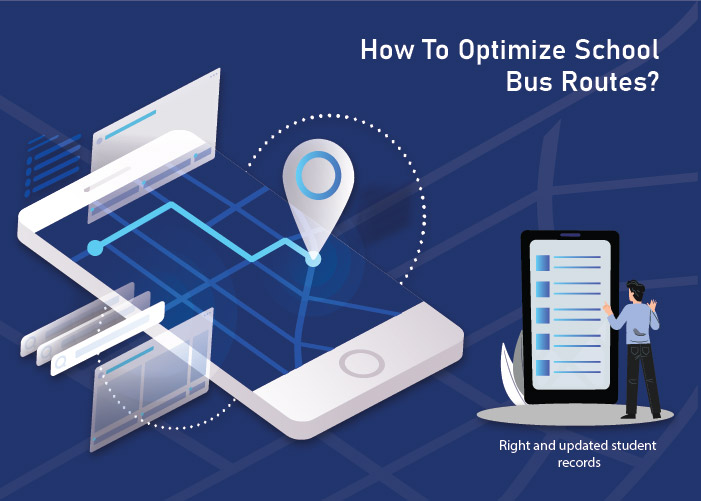Transportation management is a critical function of school administration. The school is expected to provide safe and reliable transportation to ferry children back and forth between school and home.
Data insights, such as unsafe driving reports, adherence to routes, and maintenance issues that help create safety and reliability, are often unavailable to the school transportation teams.
As fleets expand, maintaining a large number of buses on schedule on various routes cost-effectively requires complete and accurate visibility into fleet operations.
That’s where a secure and dependable school bus tracking system, combined with the power of analytics and data insights, comes in.
A next-gen school bus tracking solution provides enhanced visibility to the operation of each school bus, thereby ensuring child safety, operational efficiency, and reduction in transportation cost.
How School Bus Tracking Analytics and Data Insights Help?
a.Schools can create a safer and more efficient transportation system with access to telematics data and analytics.
Vehicles are equipped with sensors that deliver a massive amount of rich data, such as real-time location tracking, dash camera video, and driver and bus statistics, all through a single, integrated, easy-to-use tracking system.
The data transmission takes place in a very secure and reliable network, and the data is available only to authorized people.
b.The data is transformed into valuable insights that can be leveraged to understand vehicle use and driver performance across your operations.
c.More than just the GPS location and routing data, the school bus GPS tracking system captures and transmits additional information, such as odometer readings, fuel consumption, idle time, diagnostics, and complete trip history, directly from the vehicle engine control unit. This information then helps to uncover:
Underused bus stops
On-time performance
Excessive idling
Other valuable metrics that help reduce cost
d.With the above data insights, school transportation authorities can monitor idling and on-time performance, track driver behavior, and perform proactive and preventative maintenance for the fleet.
Enhanced understanding of vehicle condition and driver behavior helps transportation teams to avoid problems before they occur.
e.Data insights enable fleet managers to make better and faster decisions in emergencies to quickly adjust routes and schedules.
f.Maintaining optimal bus performance and improving overall fleet safety help lower insurance premiums.
i.Automating record-keeping and data collection helps fleet managers meet all required safety standards, compliances, and applicable state and federal regulations.
How School Bus Tracking Analytics and Data Insights Help Cut Transportation Cost?
As the school budgets become tighter, fleet managers are under constant pressure to keep transportation costs low. Therefore, it becomes imperative for them to control every penny spent.
With the right school bus tracking solution, they can reduce operational expenses in many ways. Having fuel costs reduced by even a half percent can substantially increase profit margins.
An advanced school bus tracking analytics provide essential data to identify the main causes of excessive fuel expenses and pinpoint fuel-inefficient drivers who need to be coached to become more economical drivers.
Key Components of School Bus Tracking Analytics and Data Insights
1.Driver Reports & Real-time Alerts: Driver behavior monitoring helps to reduce the operational cost of fleets. Research indicates that driver behavior can impact fuel consumption by up to 33%.
Weekly driver reports and real-time alerts show where, how many times, and how much exactly the driver has done over speeding, unnecessary long idling, hard braking, and sudden acceleration.
These alerts help the transportation team to monitor driver discipline and fuel wastage and then coach them to become safer and more fuel-economy drivers. Let us understand how the following 4 factors relating to driver behavior will impact the fuel cost of your vehicle.
Four Factors Impacting Fuel Cost:
a.Long Idling: When a vehicle is idle and stationary, fuel is consumed to allow the engine to work. Some fuel is indeed lost when a vehicle is restarted. But more fuel is lost during idling than restarting, even if the vehicle remains on for a short period while stationary. Therefore, if the idle time of a vehicle is reduced, it will cut fuel costs.
b.Over-Speeding: A vehicle’s optimal speed is around 80-90kph. When the vehicle speed goes over this range, fuel mileage decreases drastically. Research indicates that a speed of 100kph and above causes the fuel efficiency of the vehicle to reduce by 25%.
c.Hard Braking and Acceleration: Hard braking and then sudden acceleration (mostly due to speed breakers and bumps) can cause the vehicle engine to consume a lot more fuel.
d.Increased RPM: The economical band for running petrol cars is between 1500-2500 rpm and for diesel cars, it is between 1300-2000 rpm. But most drivers run their vehicles way above these bands.
Maintaining the right gear so that the Revolutions per Minute (RPM) stay within the economical bands helps in optimal engine performance and saving fuel.
2.Route Analytics: Routing data helps transportation teams to map out the school bus route and set stoppages. It helps teams to keep a track of the routes that drivers take daily and advise them to take the optimal route.
Optimal routes cut the unnecessary miles driven and reduce the amount of fuel consumed by a vehicle, thereby saving both fuel and labor costs. Efficient routing of buses also helps to reduce wear and tear and increase their longevity.
3.On-Board Diagnostics & Trip Details: The On-Board Diagnostics (OBD) Device in your vehicle helps to monitor the driver’s driving behavior and save fuel.
It shows how much fuel mileage your vehicle got, the distance driven, and the average speed at which the driver drove for each trip. Trip details also include a performance review of the driving by showing driving alerts for each trip.
4.Vehicle and Engine Health Diagnostics: Real-time vehicle diagnostics (battery condition, coolant temperature, and emission control), engine diagnostic fault code alerts, engine utilization reports with digital inspection forms, and periodic maintenance updates help fleet managers to prevent vehicle breakdowns, reduce downtime, automate routine inspections, improve vehicle utilization, and avoid costly unplanned repairs.
Streamlining and optimizing fleet maintenance helps to speed up reporting and resolution of maintenance issues, thereby saving 10- 20% in repair costs.
With vehicle diagnostics, mileage, and fleet health report, the school administration can worry less about the fleet’s well-being and focus more on student welfare.
Conclusion:
With so many factors to consider in fleet management, the transportation teams may not have the time or resources to monitor them manually.
With today’s technology-driven fleet management solution, tracking and monitoring all aspects of fleet operations has never been easier!
The real-time transportation intelligence and data analytics help to improve fleet efficiency and overall financial performance while maintaining all compliance’s.
So, is your school using an efficient school bus tracking app combined with analytics and data insights?
A robust school bus tracking software offers easy-to-use dashboards and real-time fleet analytics that help maintain high standards of safety and efficiency by monitoring driver behavior data, location tracking, and vehicle health diagnostics.
Call +971 525234328 to schedule a Free Personalized Demo and find out how Fleetroot software can help increase fleet performance and reduce transportation costs.


